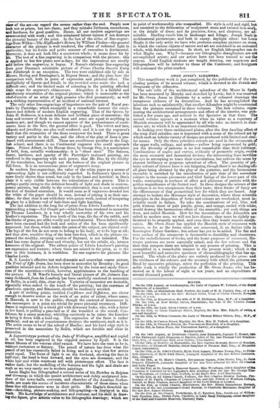OWEN JONES'S ALHAMBRA
This magnificent work is just completed, by the publication of the con- cluding portion of its second volume; which is devoted to the Details and Ornaments of the Alhambra.
The sole relic of the architectural splendour of the Moors in Spain has been measured by Murphy and sketched by Lewis; but it was reserved for Mr. Owen Jones to illustrate by a series of coloured drawings the sumptuous richness of its decorations. And he has accomplished the laborious task so satisfactorily, that another Alhambra might be constructed from the pictures contained in these volumes. The first volume, repre- senting the architectural arrangements and effect of the interior, was pub- lished a few years ago, and noticed in the Spectator at that time. The second volume appears at a moment when its value as a repertory of Moorish ornament will be appreciated by all who take an interest in deco- rative art; to which it is an important contribution.
In looking over these emblazoned plates, after the first dazzling effect et the coup d'ceil subsides, one is impressed with a sense of the refined art by which such an infinite variety of designs are produced with limited and simi- lar means. Only the three primitive colours are used in the ornaments of the upper walls, ceilings, and arches—yellow being represented by gold; yet the diversity of patterns is no less remarkable than their intricacy, Combinations of angles and curves, evidently of geometric origin, evolve the most eccentric and fantastical devices; the intersecting lines bew nate the eye in attempting to trace their convolutions, but enliven the sense b7 piquant brilliancy or gorgeous splendour of effect. The quantity of pie- maty colours of intense hues is not fatiguing, though there is no shading offr all glare being obviated by the play of the patterns; and the harmonious ensemble is enriched by the introduction of pale tints of the secondary. colours in the mosaic pavements and tiled linings of the lower part of the walls; contrasting in coolness of effect and plainness of pattern with the golden magnificence of the fretted roof. In these designs the science of the Arabians is no less conspicuous than their taste: these freaks of fancy are the efflorescence of that geometrical lore for which they are famed. Any attempt to imitate the Moresque style of decoration, where these scientifto principles in the disposition of forms and colours are overlooked, must in-, evitably result in failure. To take the combinations of red, blue, and gold, without those of pale purple, green, and orange, cooled with white, would destroy the harmonious effect of the ensemble: yet such things are done, and called Moorish. How far the decorations of the Alhainbra are suited to modern uses, we will not here discuss: they must be rightly un- derstood to be properly applied, and even then they would require modift. cation. Mr. Owen Jones has applied the Moorish style of ornament with success, so far as the forms alone are concerned, in an Italian villa in Kensington Palace Gardens; but colour has yet to be added. The flat and even surface of the ornaments is favourable to durability and chasteness. For the embellishment of books, and the lesser purposes of ornament, Mo- resque patterns are more especially suited; and the few colours and flat tints that compose them are adapted to any process of printing. This is exemplified in a remarkable manner in the present work; which is the most beautiful and extensive specimen of chromalithography that has ap- peared. The whole of the plates are entirely produced by the press: and the vividness of the colours, and the accuracy with which the patterns ars fitted by successive printings, attest the perfection of the printing. nit noble work is wholly the production of Mr. Owen Jones; who has be-
stowed on it the labour of eight or ten years, and an expenditure of several thousand pounds.


























 Previous page
Previous page